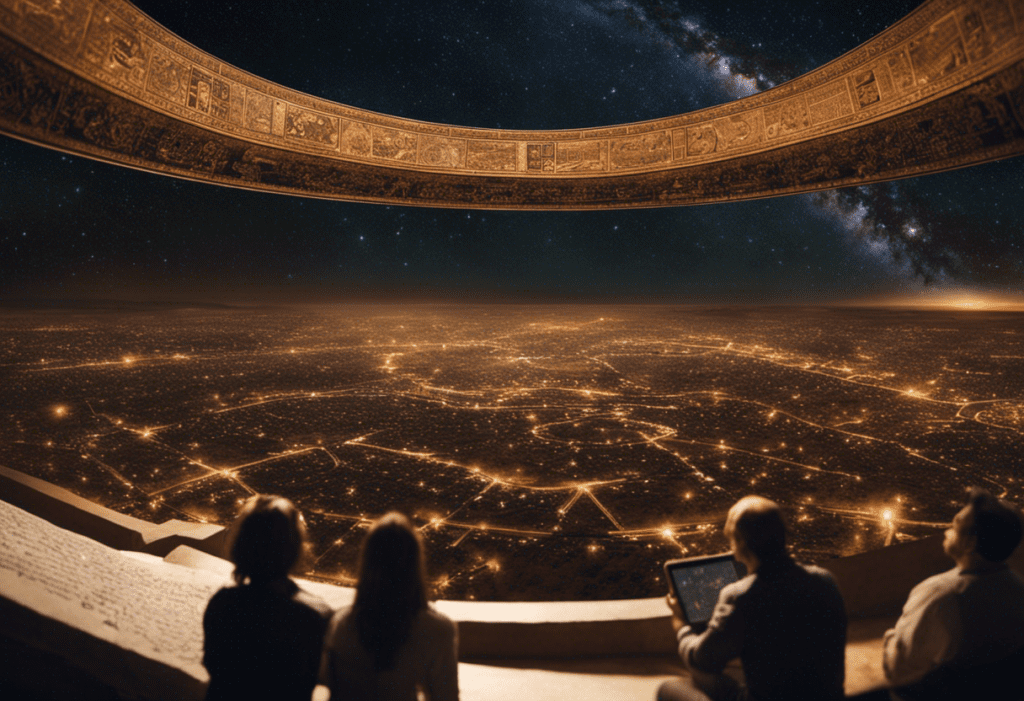In the intricate tapestry of time, the Babylonian calendar stands as a remarkable testament to the profound role of astronomy in ancient civilization. Like interlocking constellations, the celestial bodies guided the meticulous calculations that shaped this calendar.
This article delves into the celestial symphony that shaped the Babylonian calendar, exploring the influence of the Sun, the Moon, planetary movements, and constellations. By unraveling the intricate mathematics and observations, we gain a deeper understanding of the celestial threads that wove through ancient Babylonian society.
Key Takeaways
- Astronomy shaped the Babylonian calendar.
- Meticulous observation of celestial bodies was key in calendar making.
- The sun’s position and movement were observed to establish the calendar.
- Lunar cycles were closely observed and incorporated into the calendar.
The Importance of Astronomy in Ancient Babylon


Significantly, the study of astronomy in ancient Babylon played a crucial role in not only their understanding of celestial phenomena but also in shaping their religious and societal practices. Astronomy’s impact on ancient Babylonian society can be seen in their development of a sophisticated calendar system.
The Babylonians recognized the importance of accurately measuring time, and their observations of the sky allowed them to create a calendar that aligned with celestial events. Ancient Babylonians used a combination of lunar and solar observations to track time. They observed the cycles of the moon and the movement of the sun to determine the length of a year and the timing of agricultural events. By carefully recording these observations, they were able to create a calendar that accurately predicted the changing seasons and the timing of religious ceremonies.
The Babylonian calendar was not only used for practical purposes but also had a significant religious and societal impact. The timing of religious festivals and rituals was determined by the movements of celestial bodies. The Babylonians believed that the gods influenced the rhythms of the universe, and by aligning their religious practices with astronomical events, they sought to maintain harmony and appease the deities.
Observing the Celestial Bodies: A Key Element in Babylonian Calendar Making


The Babylonians’ meticulous observation of the celestial bodies was a key element in their calendar making, as their precise recordings allowed for accurate predictions of astronomical events. The Babylonians were among the first civilizations to develop a sophisticated understanding of celestial phenomena, and they used this knowledge to create a highly accurate calendar system. Their observations of the movement of the sun, moon, and stars allowed them to determine the length of the year and the timing of important events such as solstices and equinoxes.
The Babylonians made regular astronomical observations and recorded their findings on clay tablets. These observations included the positions of the sun and moon, the appearance and disappearance of certain stars, and the occurrence of eclipses. By carefully analyzing these records, Babylonian astronomers were able to discern patterns and make predictions about future celestial events. This knowledge was crucial for the development of their calendar system, which was based on a combination of lunar and solar cycles.
The accuracy of Babylonian astronomical observations can be seen in their ability to predict eclipses with remarkable precision. For example, the Babylonians accurately predicted a lunar eclipse that occurred on April 15, 136 BC, nearly 2,000 years before the development of modern astronomical techniques. This level of accuracy was possible due to their meticulous observation and recording of celestial phenomena.
The Sun’s Role in Establishing the Babylonian Calendar


Due to its central position in the sky and its predictable movement, the sun played a vital role in establishing the Babylonian calendar, allowing for the accurate measurement of time and the determination of important celestial events.
The Babylonians carefully observed the sun’s position and conducted various solar observations to understand its patterns and incorporate them into their calendar system. This enabled them to divide the year into smaller units and accurately predict the changing seasons and agricultural cycles.
Here are four key ways in which solar observations influenced the development of the Babylonian calendar:
- Determining the length of the year: By closely observing the sun’s position, the Babylonians were able to determine the length of a solar year, which they divided into twelve months.
- Establishing solstices and equinoxes: Solar observations allowed the Babylonians to identify the solstices and equinoxes, which marked important points in the solar year.
- Tracking the sun’s daily movement: The Babylonians carefully tracked the sun’s daily path across the sky, allowing them to divide the day into smaller units and develop a timekeeping system.
- Predicting celestial events: Solar observations also allowed the Babylonians to predict celestial events like eclipses, which held great cultural and religious significance.
Tracking Lunar Cycles: The Moon’s Influence on Babylonian Timekeeping


Throughout their observations of the lunar cycles, the Babylonians were able to refine their timekeeping system by incorporating the moon’s influence into their calendar, allowing for a more accurate measurement of time. The Babylonians recognized that the moon went through different phases, which they divided into 30 equal parts, corresponding to the approximate duration of a lunar month. These lunar phases played a significant role in the Babylonian calendar, as they were used to mark the passage of time and determine the start of each month.
Additionally, the Babylonians closely monitored lunar eclipses, which occur when the Earth casts a shadow on the moon. These celestial events provided important data for the Babylonians to further refine their lunar calendar. By recording the dates and times of lunar eclipses, the Babylonians were able to make precise calculations and predictions about future eclipses. This knowledge not only enhanced their understanding of the lunar cycles but also allowed them to adjust their calendar to align with the moon’s movements more accurately.
The Influence of Planetary Movements on the Babylonian Calendar


During their meticulous observations, the Babylonians recognized the correlation between the movements of planets and the structure of their calendar, thus incorporating these planetary influences into their timekeeping system. The Babylonians were keen astronomers who closely observed celestial events and their impact on the Earth. They believed that the movements of the planets held great significance and could influence various aspects of their lives.
Here are four key ways in which planetary alignments and celestial events influenced the Babylonian calendar:
- Determining the start of the year: The Babylonians used the heliacal rising of certain planets, such as Venus and Jupiter, to mark the beginning of the new year. These planets were associated with important deities and their appearances were believed to bring blessings and divine favor.
- Predicting agricultural cycles: Planetary alignments were considered indicators of favorable or unfavorable conditions for agriculture. The Babylonians believed that certain configurations of planets could affect the growth of crops and the success of agricultural endeavors.
- Forecasting natural disasters: The Babylonians also believed that planetary movements could provide insights into potential natural disasters such as floods or droughts. They carefully observed the positions of the planets to predict and prepare for such events.
- Determining auspicious times for important activities: The Babylonians used planetary alignments to determine auspicious times for important activities such as marriages, births, and royal coronations. They believed that aligning these events with favorable planetary positions would bring good fortune and success.
Overall, the Babylonians incorporated planetary influences into their calendar to guide their daily lives, ensure agricultural success, and seek divine favor. Their careful observations and recognition of the correlation between planetary movements and various aspects of life demonstrate their advanced understanding of astronomy and its practical applications.
The Significance of Constellations in Babylonian Astronomy and Calendar


The significance of constellations in Babylonian astronomy and calendar is evident in their meticulous observations and recognition of the correlation between celestial patterns and their timekeeping system. The Babylonians believed that the positions of stars and constellations held great significance in predicting the seasons and guiding their daily lives. They developed a sophisticated understanding of the night sky and incorporated this knowledge into their calendar.
One of the key aspects of Babylonian astronomy was the recognition of the positions of stars and constellations as markers of time. By carefully observing the movement of stars and their positions in relation to specific constellations, the Babylonians were able to track the passage of time and determine the seasons. They assigned specific meanings and symbolism to these celestial patterns, which they then incorporated into their calendar.
The astronomical symbolism in the Babylonian calendar can be seen in the naming and division of months. Each month was named after a particular celestial event or constellation that was prominent during that time. For example, the month of Nisan was named after the constellation Aries, which marked the beginning of spring. This connection between the calendar and the night sky allowed the Babylonians to align their daily lives and religious ceremonies with the celestial cycles.
Astronomical Calculations: The Precise Mathematics Behind the Babylonian Calendar


Astronomical calculations played a crucial role in the development of the Babylonian calendar. It required complex mathematical computations to accurately track celestial movements. The Babylonians understood the importance of astronomical accuracy and precision. They knew that in order to establish a reliable calendar system, they needed to be meticulous in their observations and calculations. Through their efforts, they were able to determine the precise durations of the lunar month and the solar year. This allowed them to create a calendar that aligned with the celestial events.
Complex Celestial Calculations
Various intricate celestial calculations were utilized to accurately determine the dates and durations of important celestial events in the Babylonian calendar system. The Babylonians heavily relied on astronomical observations to track the movements of celestial bodies and predict celestial events. These calculations were essential for the development and functioning of their calendar, which played a crucial role in their society and religious practices.
- The positions of the sun, moon, and planets were regularly observed to determine the start and end dates of months and years.
- Lunar observations were used to predict lunar eclipses and establish the length of the lunar month.
- Solar observations were crucial for determining the timing of solstices and equinoxes, which marked the changing seasons.
- The visibility and movements of stars were also observed to establish the timing of religious festivals and agricultural activities.
The Babylonian calendar system demonstrates the sophisticated understanding and application of astronomy by ancient civilizations.
Astronomical Accuracy and Precision
Precise astronomical calculations played a pivotal role in accurately determining celestial events and establishing the Babylonian calendar system. The Babylonians, renowned for their advanced knowledge of astronomy, relied heavily on celestial observations to measure the passage of time and predict future astronomical events.
By carefully observing the movements of celestial bodies such as the Sun, Moon, and planets, they were able to develop mathematical models and algorithms that enabled them to make accurate predictions. These calculations formed the foundation of the Babylonian calendar, which was based on a lunisolar system that incorporated both lunar and solar cycles.
The Babylonians’ mastery of astronomical calculations allowed them to track the seasons, plan agricultural activities, and observe religious festivals with precision. Their accurate calendrical system was a testament to their scientific acumen and laid the groundwork for subsequent civilizations’ understanding of timekeeping and celestial events.
Conclusion
In conclusion, astronomy played a crucial role in the development of the Babylonian calendar. By observing the celestial bodies, such as the sun, moon, and planets, the Babylonians were able to track and predict various astronomical events.
These observations and calculations formed the basis for their calendar system, which was intricate and precise. The Babylonians’ understanding of astronomy not only helped them keep track of time but also influenced their religious and cultural practices.
The legacy of their astronomical knowledge continues to impact our understanding of ancient civilizations.



